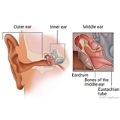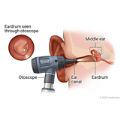Treatment Overview
Most ear infections go away on their own. But antibiotics are recommended for children under the age of 6 months and for children at high risk for complications.
You can treat your child at home with an over-the-counter pain reliever like acetaminophen (such as Tylenol), a warm washcloth on the ear, and rest. Your doctor may give you eardrops that can help your child's pain.
Do not give aspirin to anyone younger than 20.
Your doctor can give your child antibiotics, but ear infections often get better without them. Talk about this with your doctor. Whether you use antibiotics will depend on how old your child is and how bad the infection is.
If your child has cochlear implants, your doctor will probably prescribe antibiotics. That's because serious complications of ear infections, including bacterial meningitis, are more common in children who have cochlear implants than in children who don't have these implants.
Follow-up exams with a doctor are important if your child isn't getting better. The doctor will check for persistent infection, fluid behind the eardrum (otitis media with effusion), or repeat infections.
Fluid buildup and surgery
Doctors may consider surgery for children who have repeat ear infections or who keep getting fluid behind the eardrum. Procedures include inserting ear tubes or removing adenoids and, in rare cases, the tonsils.
Fluid behind the eardrum after an ear infection is normal. And, in most children, the fluid clears up within 3 months without treatment. If your child has fluid buildup without infection, you may try watchful waiting.
Have your child's hearing tested if the fluid lasts longer than 3 months. If hearing is normal, you may choose to keep watching your child without treatment.
If a child has fluid behind the eardrum for more than 3 months and has significant hearing problems, then treatment is needed. Sometimes short-term hearing loss occurs. This is especially a concern in children ages 2 and younger. Normal hearing is very important when young children are learning to talk.
If your child is younger than 2, your doctor may not wait 3 months to start treatment. Hearing problems at this age could affect how well your child can speak. This is also why children in this age group are closely watched when they have ear infections.
Repeat ear infections
If a child has repeat ear infections (three or more ear infections in a 6-month period or four in 1 year), you may want to think about treatment to prevent future infections.
Ear tube surgery may be an option if your child has repeat ear infections. Ear tubes are plastic and are shaped like a hollow spool. They help to clear fluid from your child's middle ear. Allowing the fluid to drain prevents the growth of bacteria that cause ear infections. Your doctor can help you decide if ear tubes are the right choice for your child.
Learn more

